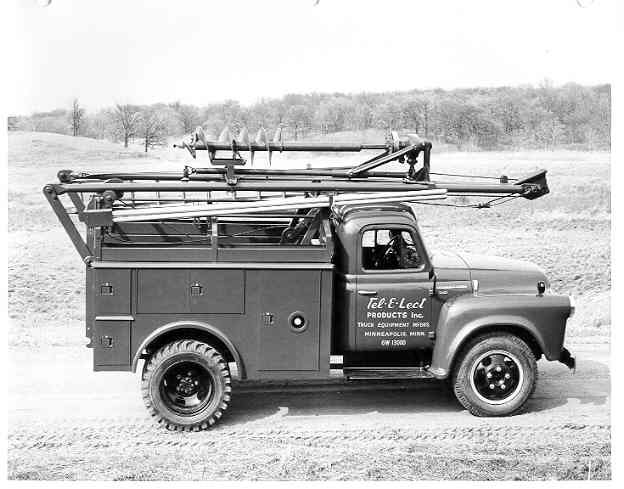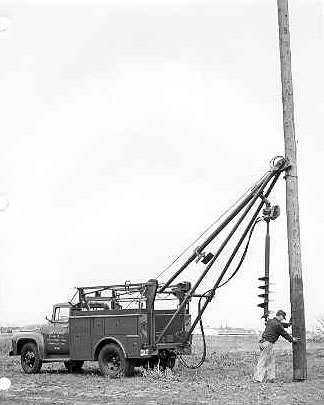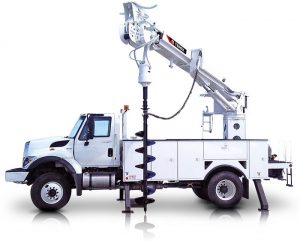From Manual to Machine: The Evolution of Digger Derricks
Written by: Amber Reed, Signature Style PR + Marketing, Huntersville, North Carolina
Provided by: Terex Utilities, Watertown, South Dakota
Today, digger derricks are one of the most used, most versatile tools on a utility line construction project. When you look at the design of these trucks, it is clear they are made to tackle a myriad of tasks ─ from digging holes and lifting and setting poles to turning in screw anchors, putting linemen in the air and setting transformers.
Because the majority of the work today’s digger derricks do include lifting and digging, these trucks have evolved over the years ─ through the engineering, development and manufacturing processes ─ to make jobsites safe and work more efficiently For more than 70 years, digger derrick manufacturers, including Terex have transformed the industry’s first vehicle-mounted augers into multi-purpose machines.
How it all began
 In the early days of electrification, power line construction was a manual process ─ crews dug holes using shove’s and hand augers, used ropes and manpower to walk the poles up into position and then refilled the holes and tamped the ground by hand. During the World War II era, the desire to be a more global community spurred the need quickly build the world’s power and communication grid. This development made it necessary for utility crews to look for ways to automate the line construction process. From this need, the first mechanical digger derrick was developed.
In the early days of electrification, power line construction was a manual process ─ crews dug holes using shove’s and hand augers, used ropes and manpower to walk the poles up into position and then refilled the holes and tamped the ground by hand. During the World War II era, the desire to be a more global community spurred the need quickly build the world’s power and communication grid. This development made it necessary for utility crews to look for ways to automate the line construction process. From this need, the first mechanical digger derrick was developed.
It all started in the 1940’s with Leroy C. Lindquist, owner of the Minnetonka Manufacturing Company which manufactured parts for the Telephone and Electric (Tel-E-lect) utility markets in Hopkins, MN. At the time, Lindquist worked with Northwestern Bell Telephone Company to develop a machine run by power take-off (PTO) on a truck’s transmission to dig holes for telephone poles more quickly. The first Tel-E-lect trucks utilized the truck’s differential to mechanically turn an auger, which was suspended from the end of an A-frame boom and was raised and lowered by the truck winch line to drill a hole.
 The concept of the digger derrick truck caught on quickly, and mass production of these trucks took off the 1950’s. The 1950’s and 1960’s also saw three Tel-E-lect digger derrick product innovations introduced that are still in use today — the Rite-Way auger storage bracket, pole grabbing (PG) winch and the hydraulic collector block. With the hydraulic collector block, digger derricks could, for the first time, rotate continuously and without restriction making them a much more versatile machine.
The concept of the digger derrick truck caught on quickly, and mass production of these trucks took off the 1950’s. The 1950’s and 1960’s also saw three Tel-E-lect digger derrick product innovations introduced that are still in use today — the Rite-Way auger storage bracket, pole grabbing (PG) winch and the hydraulic collector block. With the hydraulic collector block, digger derricks could, for the first time, rotate continuously and without restriction making them a much more versatile machine.
In the 1960’s and 1970’s, hydraulic digger derricks were introduced. These trucks were also designed to be mounted on a smaller, lighter and more maneuverable chassis, giving crews more flexibility and versatility with their fleets. Digger derricks during this era were also engineered with strong box-constructed booms and powerful dual lift cylinders, a configuration so sturdy and reliable that it is still the standard today. This decade also saw the introduction of the digger derrick’s first fiberglass third section built to eliminate pin-on third sections.
Terex purchased Tel-E-lect, the manufacturer at the forefront of the digger derrick evolution, in 1997 from Simon Engineering. This acquisition became the foundation for Terex Utilities, a business unit of Terex Corporation, who is today one of the world’s leading suppliers of digger derrick trucks and support products.
Where we are now
Throughout the decades, all of these trucks’ innovations and enhancements were rooted in the industry’s acceptance of the need for and the uses of digger derricks. The main components of a digger derrick are the pedestal, the turntable, the booms, the cylinders for boom control, the outriggers or stabilizers, the digger motor, the auger and auger teeth and the controls. From digging to lifting, these trucks are designed to literally do it all.
As digger derricks have gained popularity, competition has increased and advancements in technology and design have become big business for utility truck manufacturers. And the customers have profited ─ today’s digger derricks can be mounted on a customer’s specified chassis and have sheave heights up to 100 ft and winch capacities of 50,000 lb. These trucks are also engineered to include platforms and top controls for use as people carriers and material handlers. By being able to position a person in the air, digger derricks are now also used for maintenance work, including replacing crossarms on utility poles, as well as construction work like erecting signs, lights and telecommunication lines.
Other engineering evolutions include radio controls which allows crews to operate the machines remotely and increased use of fiberglass components to improve insulation for safe and more productive work around energized power lines. Features such as advanced hydraulic systems for improved efficiency and controllability and boom tip configurations, such as “transferable tilt pole plummer,” to aid work practices are also innovations incorporated into today’s digger derricks.
How digger derricks work
The most important measure of how a digger derrick performs is called the “Load Moment,” which is a calculation that takes the geometric derivatives of boom angles, the distance of the winch line or auger from the center line of rotation and the lifting capacities of the equipment into account.
When operators dig a hole for a pole, for instance, they have to consider how far away from the truck they are going to dig, what kind of soil they’ll be digging in, along with how deep and wide they will have to make the hole. All of these factors impact the digging capacity the truck needs to have to complete the task. Operators also have to know the pole specifications, including height, weight and diameter in order to determine the best “hooking” point to achieve lifting capacity.
Most operators set their derricks within 2- to 3-ft of the maximum digging radius, no matter what size the hole. The 2- to 3-ft of boom reserve assists in keeping the pole hole as straight as possible. For instance, a digger derrick with a sheave height of 47 ft has a maximum digging radius of approximately 26 ft with a boom angle of 0 degrees. When digging, the boom angle will drop to less than 0 degrees as the hole goes deeper. Operators need that extra room to extend the boom and keep the digger moving down in a straight line. Taking that into account then, the operator would set up the unit to dig a hole at 23- to 24-ft out from the centerline of rotation.
However, if the digging conditions are less than optimum due to wet, heavy material, and the digger derrick is set up to use a larger auger diameter, such as a 24-in, 30-in or more, the operator may have to reposition the digger derrick to achieve the ability to lift the auger, full of material, back out of the hole while digging. Adding the extra step to reposition the truck can impact the overall efficiency of the crew constructing a new power line or changing a pole.
After digging the hole, the operator will set the pole by positioning a sling around it, attaching it to the winch-line hook and lifting it to an upright position where the derrick can “grab” it and position it into the hole which should be fairly easy to accomplish — as long as an operator knows the parameters of the load the truck is lifting and is able to match that to the lifting capacity at the radius within the truck’s “work zone.”
Different comparison methods
Throughout the evolution of digger derricks, various methods have been used by fleet managers and linemen to compare the working capacities of trucks built by different manufactures. Early on, digger derricks were compared by their capacity rating with the booms fully retracted and fully elevated, but as these are not practical working positions, comparisons had to evolve to better reflect how these utility trucks were being used.
Traditionally, the design of a digger derrick requires an emphasis on either the digging capacity or lifting capacity so most comparison methods have included:
- Winch capacities ̶ a comparison of the styles and capacities of winches;
- Lifting capacities ̶ a comparison that accounts for both the boom strength and the capacity and style of winch;
- 10-ft radius lifting capacity ̶ a “working” comparison developed by Tel-E-lect in the early 1980s that considers a truck’s ability lift loads within a 10-ft radius from the centerline of truck’s rotation.
It is important to understand the differences of these more recent specifications and comparison methods as they often do not account for all of a digger derrick’s capacities. For instance, none of these comparisons take into account for a truck’s in-the-hole (ITH) digging and out-of-the-hole (OTH) lifting capacities.
Where we’re going
 To select the right digger derrick for the job, comparison standards that reflect not only the boom’s lifting capacity but also accounts for the digger derrick’s auger digging and lifting capacity. These capacities need to be close in order to make sure the truck is able to lift the auger, while full of material, out of the hole. Simply put: The truck needs to be spec’d so that it is able to dig a hole and set the pole without the need to reposition. For this reason, a new comparison standard promoted by Terex ─ the Work Zone Capacity ─ gives utility companies and contractors the confidence to select a truck that is properly sized to perform all of the jobs it is tasked to do.
To select the right digger derrick for the job, comparison standards that reflect not only the boom’s lifting capacity but also accounts for the digger derrick’s auger digging and lifting capacity. These capacities need to be close in order to make sure the truck is able to lift the auger, while full of material, out of the hole. Simply put: The truck needs to be spec’d so that it is able to dig a hole and set the pole without the need to reposition. For this reason, a new comparison standard promoted by Terex ─ the Work Zone Capacity ─ gives utility companies and contractors the confidence to select a truck that is properly sized to perform all of the jobs it is tasked to do.
The work digger derricks do for utility companies and contractors is too valuable to have the wrong size of truck on a job. In an increasingly competitive bidding environment, it is more important than ever that a digger derrick be spec’d to complete the jobs it is tasked to perform, on-time and on-budget. In order to best match a digger derrick with the tasks it needs to do, customers have started asking their equipment manufacturers and distributors to provide them with the truck’s Work Zone Capacity — the only standard that takes into account all of a truck’s capabilities.
For 70 years, utility professionals have used digger derricks in electric, utility infrastructure (power line and transmission) and telecommunication applications. Today’s utility professionals know that the secret to being successful on any job is to equip crews with the right equipment to match the application. Digger derrick products are steeped in the traditions of the people who first developed them — hard-working and inventive. The goal of today’s digger derrick trucks continues to be focused on providing customers with state-of-the-art equipment solutions that help them get each and every project done safely, quickly and at the lowest cost of ownership.
Learn more at www.terex.com/utilities
Share on Socials!
Spot Heating Solutions – Keeping Cozy in Every Space
Carhartt Continues Support of Skilled Trades with Labor Day Donation Benefitting Team Rubicon’s Veteran-Led Skilled Job Training Program
The Contractors Guide: Easy Smart Home Updates
Leaders in Electrical Safety
• Aramark
• Bowtie Engineering
• Enespro
• Ericson
• I-Gard Corporation
• IRISS
• KERMEL, INC.
• Lakeland Industries
• MELTRIC Corporation
• National Safety Apparel
• National Technology Transfer
• Oberon
• Saf-T-Gard
• SEAM Group
Subscribe!
Sign up to receive our industry publications for FREE!








